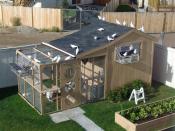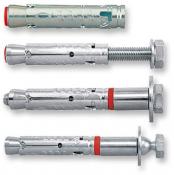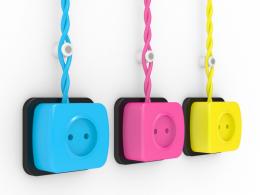Search
Login
Installing the outlet, how to install the outlet, step-by-step instructions
It is difficult to imagine how it is possible to use such a benefit of modern civilization as electricity, if there were no outlets, which are very convenient devices that allow you to instantly connect any electrical devices to the network. A detachable connection option allows you to change the location of electrical appliances depending on the desire of the owners.
Content:
- Functional features of sockets
- The design of a modern outlet
- Socket for open installation - installation features video
- Concealed installation socket and its installation video
- Installing the power outlet video
- Useful Tips video
Functional and design features of modern outlets
Although the design of the outlets is extremely simple, they:
- ensure stable contact between electrical appliances and mains connectors
- provide protection against accidental or intentional contact with conductive network elements, this is especially important if there are curious kids in the room without adult supervision,
- reliably protect and isolate live parts of the wiring from each other and from the enclosures of electrical devices,
- in the case of using polarized plugs - they allow to exclude incorrect connection to the network of devices with single-pole switches,
- almost all modern types of sockets are equipped with a special contact to which you can connect the ground loop,
- exclude the possibility of connecting devices not designed for mains voltage,
- provide fire safety in the event of emergency situations in the wiring.

It is important that the elegant appearance of modern outlets does not spoil the overall design of the room.
Since sockets are a product in high demand and the requirements for them are quite diverse, manufacturers consider it advisable to produce these products in a fairly wide range of models.

In any of the construction supermarkets, you can choose sockets of different designs, colors, functional purpose. Of course, the variety of products offered makes it somewhat difficult to choose, but it is quite possible to simplify the task - for this you will need to first study the design features of modern sockets of various types, to familiarize themselves with their classification.
As for the design of outlets, for the most part they are modular, i.e. with the identical working part of the device, you can get the most diverse design, for this you just need to purchase and replace decorative covers.
The design of a modern outlet
The main elements of sockets are the contacts. The life of the device is often determined by the quality of the materials used in their manufacture.

The outlet contacts are divided into two types:
- sockets for entry of pins
- equipped with clamps, keyboard or screw, for reliable connection of electrical wiring.
Decorative details of outlets are made of non-combustible plastics, which are distinguished by electrical insulation properties and aesthetics.
The housing of the working part in imported models is made of high-strength plastics. The domestic manufacturer still produces sockets with a porcelain working part, but such products do not differ in particular practicality, in view of the fragility of the material.

To make the contact created reliable, spring-loaded contacts are installed in the receptacle sockets of the outlets, the quality of the connection is ensured by the fact that their diameter is slightly smaller than the diameter of the plug pins. those. the connection is especially strong.
A simple constructive solution of the sockets will allow you to install them yourself, it is extremely undesirable to neglect safety measures during operation. Installation of sockets can be done in a hidden way or externally if the option of open wiring is used.
Socket for open installation - installation features
Most often, the open wiring installation is used in technical rooms, garage, bath. The advantages of this solution include the availability of installation and replacement of structural parts that have failed and the simplicity of identifying problems and resolving them.

But it should be borne in mind that the cost of an external outlet will be slightly higher, and use in a room is unlikely to increase the attractiveness of the interior. A socket, respectively, will be required suitable for outdoor installation.
Before. how to start installation, you need to make sure that there is no voltage in the network, i.e. after de-energizing the premises, we will use a screwdriver with an indicator.
Then you need to disassemble the housing of the outlet, consisting of a front cover and a back, on which the core is located. It is the back cover that will need to be attached to the surface of the wall. First, install it strictly horizontally, mark with a pencil the points of location of the mounting holes. With the help of a drill, we drill these same holes and insert the dowels. Next we fasten the cover using screws.
To exclude the possibility of spontaneous combustion, experts recommend laying a paronite gasket between the wall and the back cover - even in case of ignition of the insulating material, the wall will be reliably protected.

The wiring and grounding contacts should be properly tightened with screws, then the front cover can be installed. On this, the installation process of the outlet can be considered complete.
About the open installation of sockets - in the video:
Concealed installation socket and its installation
Internal outlets are installed if the wiring in the room is laid in the gates made in the walls and ceilings. In this case, the first to install a sock. In our case, we will consider installing a socket with a grounding contact, as we mentioned above, it is precisely such models of sockets that can, in most cases, be found on sale.
Unlike the option that was considered above, the recessed housing of the hidden installation outlet will not be very evident and spoil the interior of the room.

Before you begin installation work, you will need to stock up on:
- plastic sockets,
- the outlet itself
- some alabaster
- screwdriver indicator, straight and curly,
- with a knife
- pliers.
The first step in the installation process is to turn off the power, do not forget to verify the correctness of the performed action using the indicator screwdriver.
Next, install the socket. Experts recommend choosing plastic models, they are inexpensive, their sizes are ideally suited to the standard dimensions of modern outlets.

The use of metal products can create problems both during installation - fixing the core with bursting paws may not be possible, or during operation - a loose housing of the outlet will soon lead to its failure.
When installing plastic sockets, it is recommended to use alabaster to fix them in a strob. The surface of the strobes in the concrete wall is moistened, a thin layer of mortar is applied, and the undergrowth is fastened.

The second option is to use self-tapping screws for fastening, but the installation quality in this case will be slightly lower. Further, the conductors of the electrical wires are inserted into the holes on the socket.
Then the installation of the housing, the part on which the connection of the contacts will be carried out, is made. Wires are thoroughly cleaned of insulation residues, the length of the cleaned surface should be about 10 mm. Then the wires are fastened in the housing. It is made with screws. First, the 3 central screws loosen, insert the cleaned cores, tighten with a screwdriver. In this case, the ground wire should be in the center, phase and zero - to the right and left of the center.

It is recommended to connect the phase to the left hole, adhering to this long tradition, specialists provide themselves with the ability to quickly search for the desired conductor in the absence of marking.
At the next stage, you will need to fix the housing in the socket. Its installation should be performed exactly, otherwise the entire outlet will be skewed, with the help of side screws the legs are bursting, providing them with a reliable fixation in the walls.
Useful advice: when choosing a socket, give preference to models with paws having two cloves - they provide reliable fixation.
There are models in which instead of the legs they use an overlaid case, for fastening in such cases, self-tapping screws will be used.
After a reliable tightening of each of the screws of the structure, it will be necessary to install a decorative part of the socket - its fastening is also carried out using screws, it will not be particularly difficult to tighten them all the way.

As you can see, the installation process is quite simple, but during its implementation it is necessary to control the reliability of the tightening of each of the cores.
Weakened joints with time will lead to the fact that the heating case begins to melt, which in turn will significantly increase the risk of spontaneous combustion of the wiring and the occurrence of a short circuit.
Visually about installing a hidden outlet - in the video:
Installing the power outlet
Modern kitchen involves the use of numerous electrical appliances that make life easier for home owners and optimize cooking processes. Since it is not recommended to use tees and extension cords in a kitchen environment on a regular basis, you will have to take care of installing an outlet block, the number of outlets in it should be carefully calculated, they should be enough to simultaneously connect devices that are usually used in the cooking process.
Sockets can be connected in parallel,

those. a star, or sequentially,

a train. With a serial connection, you will need to install a distribution box, from the common buses installed in it, separate wires will be fed into each of the outlets.
When using a parallel connection, in-depth sockets are used, in which the wires are wired. Instead of sockets, in this case, plugs are installed that will not contribute to the deterioration of the appearance of the wall. If the connection of sockets will be carried out by a loop, using jumpers installed in pairs in each terminal clamp, then the additional depth of the socket will not be required.
Detailed instructions for installing the outlet block - in the video:
Useful Tips
Although the process of installing outlets is very simple, it will not be out of place to listen to the tips that experienced electricians give:
- If you need to connect several electrical appliances at the same time, you should initially plan to install several outlets located on different walls in the room, to install double outlets or outlet blocks, a correctly designed circuit eliminates the need to lay several lines, all products can be connected by cable.
- The ribbed inner walls of the sockets allow more reliable contact with the bursting legs during installation.
- It is recommended to improve the smooth walls of the undergrowth a little: mark the points of the hooks of the legs and give them unevenness with the help of a chisel.
- To smoothly fix the core of the socket, screw in the screws of the foot spread alternately, fully screwing one screw, then the other, can cause a skew.
- The height of the installation of outlets is not strictly regulated, except in special cases, they are installed at a height of about 0.6 m from the floor. An installation at a height of about one and a half meters can be envisaged for a children's room - it will be quite convenient for adults to use such a socket, the child will practically not be at risk of electric shock, it is necessary to take into account the possibility of various kinds of problems, because the curiosity of the kids has no limits. The minimum installation height of the outlets is 0.2 m from the floor - otherwise there will be a risk of water entering the surface of the outlet during wet cleaning, the consequences can be extremely negative.
- If the cable breaks in the strobe, but it is impossible to exclude this possibility, a situation may arise when the length of the wire will not be enough to connect the outlet. Experts recommend giving preference to the connection using terminal blocks.
- During installation, contacts should be made from above - this will simplify the maintenance process and repair work.
When choosing and buying outlets, you should give preference to trusted and reliable manufacturers:
- Schneider electric
- Legrand
- Bticino
- Makel
- Viko.
The products of these companies with a sufficiently high quality, reliability and stylish design, are quite reasonable prices.
Useful information about the types of modern outlets and recommendations on choosing the right model - in the video:





